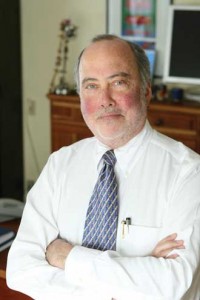
By Neale McDevitt
It has been 75 years since Dr. Wilder Penfield saw his dream come to fruition with the opening of the Montreal Neurological Institute (MNI), integrating cutting-edge neuroscience research with the most advanced and compassionate care for patients with neurological diseases. A world leader right out of the gates, the Neuro has cultivated a spirit of innovation that, in 2007, led to it being named one of the Canadian Government’s seven national Centres of Excellence in Commercialization and Research. Recently, the McGill Reporter had a tête-à-tête with David Colman, Wilder Penfield Professor in Neuroscience; Canada Research Chair in Neuroscience and Director of this venerable institution, to talk risk, reward and science that dares.
Where is The Neuro situated in the pantheon of world medical institutions?
We are the Cirque du Soleil of science – absolutely unique in the world. We are daring, innovative and unafraid of risk or failure.
In today’s economic climate “risk” and “failure” aren’t two words you’ll find in most business plans.
Of course, we are concerned with the business model to the extent that if we develop something useful to the world then business and marketplace come into it. But we don’t run the Neuro like a business. A lot of what we do, we give it away.
When you’re dealing with patient care, you don’t cut corners. If someone wants you to cut corners then they aren’t your friend.
How does The Neuro differ from similar institutes?
For most of the world, the model is to create a big hospital and stick on these little institutes like barnacles on a whale’s behind. There’s not very much cross-talk between clinicians and researchers.
What Penfield did – and if Penfield was a genius at anything, he was an administrative genius – was to create this big institute with a specialized hospital sitting within the institute. Total cross-talk.
We are the model for the 21st century. This notion that the institutes are remote and removed from clinical activities is outdated and it just doesn’t work.
Does that mean all your clinicians are researchers?
No. We have some first-rate clinicians who only do clinical work. But they are made better because they are surrounded by people who are endlessly curious – and they are too, otherwise they wouldn’t be here.
So you don’t mind rolling the dice when it comes to research?
You can always put together existing technology and do a project; it’s targeted science and it has a real value. It’s the reason Canada was so successful at squashing the SARS crisis. But nothing new has been created.
In a place like this where we rely on innovation, we don’t really know how things are going to turn out. If we knew, it wouldn’t be innovative.
Science is like the myth of Ariadne’s thread and the Minotaur’s labyrinth. We know where it will begin, but we don’t know where it will end. We aren’t afraid to walk into the cave with our spool of thread. We may only get halfway and hit a wall. Then there are two options: you can bang your head up against the wall for the next 20 years or you can back up and take another way.
Again, in tough economic times, isn’t “safe science” a more popular option?
In times like these, lots of institutions become even more risk-aversive and more apt to take a targeted approach. That way they can go to the government and say, ‘See? You gave us money and we did what we said we were going to do,’ rather than ‘You gave us the money and we made no promises. Sure enough we don’t have any answers for you now – but we do have new directions to follow.’
Is it tough to find funding for all this, given this approach?
We excite donors by telling them the truth about how we work. We tell them that we have these high-risk projects that need support, projects that our smartest people think will work out – although we don’t quite know when and/or how. People respond to our honesty. Our track record for success doesn’t hurt either.
Since launching our Thinking Ahead Campaign two and a half years ago, we’ve raised close to $40 million, and our annual campaign brings in $1 million annually.
What are the end results of all this curiosity and risk-taking?
The patients benefit because we are trying to produce tomorrow’s therapies. We have a program in experimental therapies that costs a good deal of money to run, but if we discover something that, for example, delays the progress of multiple sclerosis, what’s that worth to the world?
How do you foster this culture of innovation?
Being a public institution has allowed us to do our work over the past 75 years without someone standing over us saying: ‘Stem cells. Drop everything else – you’ve got to do stem cells.’ There are whole institutions devoted to singular enterprises but it is a recipe for failure. We are the biggest medical centre in the world devoted specifically to neurology, neurosurgery and neuroscience. We do a lot of things and we do them well. You need everyone – director, staff, faculty and students – to strive to be ahead of the curve. As [philosopher George] Santayana said to his students, “Don’t be safe. Be brilliant.”
